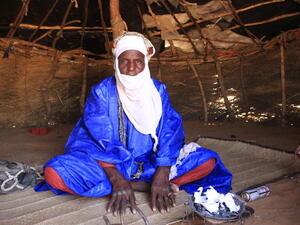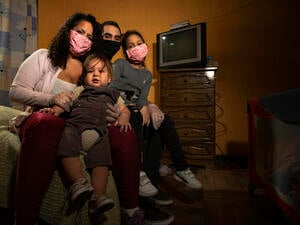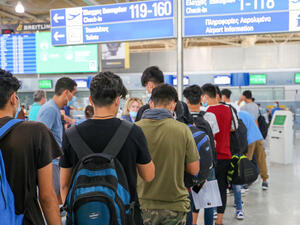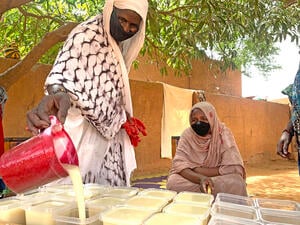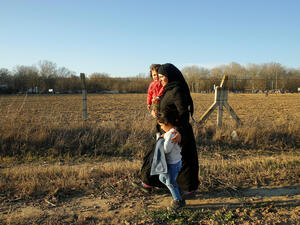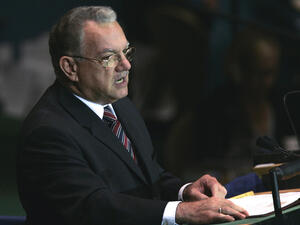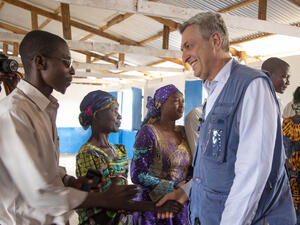Fortress Europe: The wall is getting higher
Fortress Europe: The wall is getting higher
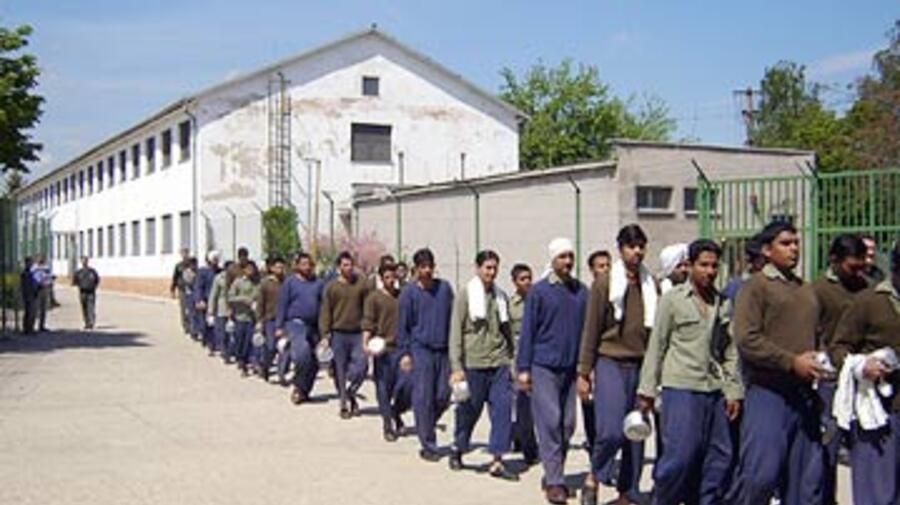
Indian and Bangladeshi migrants and asylum seekers in the Secovce detention centre, eastern Slovakia, where guard dogs were recently removed after protests from humanitarian organizations.
BUDAPEST, April 26 (UNHCR) - The picturesque stretch of the Carpathian mountain range which marks the frontier between Ukraine and Slovakia is, despite its remoteness, rigorously patrolled on both sides of the border. For this route is being increasingly used by both migrants and refugees alike as an entry point into the European Union.
On the Ukrainian side of the border, guards patrol day and night, intercepting people trying to cross illegally. The numbers are on the rise. While only 947 people were intercepted at the Ukrainian-Slovak border in 2003, a year later the number had climbed to 2,274 and, by 2005, doubled to 4,486. Non-governmental organisations estimate that these figures represent about 50 percent of people attempting to cross the border. It is thought that 80 percent of those who escape the Ukrainian patrols are then caught by the Slovak authorities on the other side.
The number of people applying for asylum on the Ukraine side of the border, in the Zakarpattia area which is the main illegal entry point into the European Union, has also increased dramatically. In 2005, the number of asylum applications increased almost four times compared to 2004. The 797 applications received accounted for almost 50 percent of all new asylum seekers registered in 2005 in Ukraine. But despite the high number of applications, overall the refugee recognition rate in Ukraine for 2005 was less than 0.4 percent. Last year, not a single person who applied from the Zakarpattia region was granted refugee status.
Recently, the majority of the intercepted individuals come from countries such as the Russian Federation (Chechens), the Republic of Moldova and Georgia, as well as the Caucasian region, but also from countries further afield such as China, India, Bangladesh and Viet Nam.
However, in the countries which make up the EU's new eastern frontier - Poland, Slovakia, Hungary and Slovenia - despite the rise in numbers of people entering the EU, there has been a sudden sharp drop in those seeking asylum. Between 2004 and 2005, the number fell 44 percent, from 21,867 to 12,190 people.
"We know there is a mixed flow of asylum seekers and economic migrants," says Lloyd Dakin, UNHCR regional representative in Budapest. "But we are extremely concerned that strict border control systems make it impossible even for refugees to cross."
Therefore, the regional office in Budapest is preparing a major border monitoring project for the next few years that will include land borders, harbours and airports.
In line with European practice, Ukrainian government policy and funding focuses more on prevention of irregular migration and on border controls. Over the last few years Ukraine has developed legislation, institutions and structures towards building an effective asylum system. But problems continue with regard to the interpretation of national legislation in line with international standards. The treatment of detainees and the detention conditions remain poor due to inadequate state budget allocations.
For example, in the Zakarpattia region, UNHCR's partner, the NEEKA Foundation, and other humanitarian organizations have to provide food, medicine, clothes, transportation, legal and social counselling, interpretation and even finance the rent of a hostel or shelter for asylum seekers admitted into the procedure, in order to ensure that asylum seekers receive at least a minimum standard of treatment.
Just across the border from Ukraine, in Slovakia, refugees and migrants, including families with small children, are kept in detention centres for up to six months. At the Secovce detention centre in eastern Slovakia, people are allowed to exercise outside for half an hour, twice a day in a courtyard surrounded by barbed wire. Guard dogs were recently removed after protests by humanitarian organisations. They are provided with food and medical care, and lawyers and social workers have access to the detainees.

In the canteen at the detention centre in Secovce, eastern Slovakia. Migrants and asylum seekers are allowed outside only twice a day for thirty minutes in a courtyard surrounded by barbed wire.
Hassan escaped his native Chechnya, and managed to cross into the EU. He is currently one of the people in the Secovce detention centre. "I do not want to kill anyone," he says, "neither my fellow Chechens nor Russians. But this is impossible in my country. And everywhere else, they tell you: You are Chechen, so you are a terrorist."
But not everyone, it seems, who is intercepted ends up in a detention centre. UNHCR has received worrying reports that some Chechens who entered EU territory, by crossing from Zakarpattia irregularly into Slovakia, were unlawfully denied access to asylum procedures there. Instead groups have been returned and re-admitted to Ukraine and then deported back to the Russian Federation.
In theory, everybody who applies for asylum should be granted access to an asylum procedure, released from detention and have their claim decided, be it in Slovakia or in Ukraine. But with the mix of migrants and asylum seekers, as well as the criminal elements involved in the profitable human-smuggling racket, law enforcement bodies tend to focus on stopping illegal migration rather than assisting asylum seekers.
UNHCR says that better systems are needed so that asylum seekers receive the help and protection they are entitled to under international law.
"The only way to distinguish between asylum seekers and those who are not is through professional authorities who can process and decide on every claim individually," says Dakin. "It is not up to border guards or other security forces to make that decision."
By Melita H. Sunjic in Budapest, Hungary
and Natalia Prokopchuk in Kyiv, Ukraine

